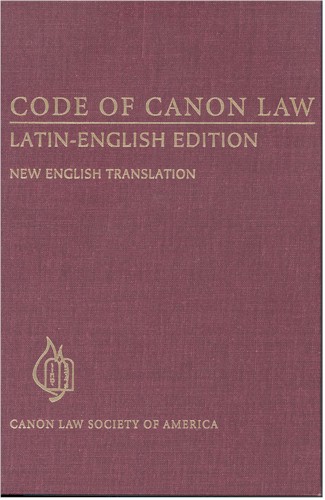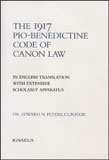| To work for the proper implementation of canon law is to play an extraordinarily constructive role in continuing the redemptive mission of Christ. Pope John Paul II |
|
2 dec 2022 | Masterpage 1983 Code | Research links
| Related
Second Vatican Council, here |
| Overview
| Master Page on the Johanno-Pauline Code of 1983
The Johanno-Pauline Code of 1983 is the largest and most important of the primary legislative documents that comprise the current canon law of the Roman Catholic Church. Called for by John XXIII in 1959, promulgated by John Paul II on 25 January 1983, and taking force on the First Sunday of Advent that year (27 November), the 1983 Code replaces the Pio-Benedictine Code of 1917 and, alongside the Code of Canons of the Eastern Churches of 1990, governs the faith life of over one billion Catholic Christians around the world.
|
| Text of the law
| Editio typica (official text)
Codex Iuris Canonici auctoritate Ioannis Pauli PP. II promulgatus, AAS 75/2 (1983) 1-320, as corrected and amended. Original version on-line here. The 1983 Code has been undergoing considerable textual modification under Popes John Paul II, Benedict XVI, and especially Francis. The best place to track these changes is here.
The formal presentation of the 1983 Code occurred on February 3, 1983, eight days after its promulgation. Abp. Castillo Lara, Cdl. Agostino Casaroli, and Pope John Paul II delivered addresses in Italian. See Communicationes 15 (1983) 27-35, 36-41, and 9-16 respectively, or Francesco d’Ostilio (Italian Conventual, 1914-2007), La Storia del nuovo Codice di diritto canonico: Revisione, promulgazione, presentazione (Libreria Editrice Vaticana, 1983) 79-103, wherein addresses are published in the order of their delivery, Eng. trans., in Pontificia Commissio Codici Iuris Canonici Recognoscendo, Promulgation and Official Presentation of the Code of Canon Law (Vatican Polyglott Press, no year given), as follows: “Discourse of the Pro-President Archbishop Rosalio Castillo Lara, sdb”, (pp. 13-23); “Discourse of Cardinal Agostino Casaroli, Secretary of State” (pp. 24-29); and “Discourse of His Holiness John Pau II” (pp. 31-39), here.
Translations
Several translations of the 1983 Code have been authorized.
The most common English translation of the 1983 Code is: Canon Law Society of America, Code of Canon Law, Latin-English Edition, New English Translation (Canon Law Society of America, 1999), on-line here. Order hardcopy here. The original English translation published by the CLSA in 1983 is now obsolete. Another authorized English translation is: Canon Law Society of Great Britain and Ireland, The Code of Canon Law in English Translation (Collins/Eerdmans, 1983) for which a separate index volume was made available. Both of these works are increasingly out of date, however, as numerous changes to the 1983 Code are produced.
Other authorized vernacular translations include: Código de Derecho Canónico, Code de Droit Canonique, Codice di Diritto Canonico, Codex des Kanonischen Rechtes, Kodeks Prawa Kanonicznego, [hold for Portuguese], and [hold for Dutch]; Kódex kánonického práva, and Az Egyházi Törvénykönyv. Also, Russian: Sancti Thomae Institutum, Moscow, 2007, 620 pp.
|
| Canonistics
| Structure of the Johanno-Pauline Code
Fundamentally the Johanno-Pauline Code consists of 1,752 canons, many of which have been subdivided into two or more "paragraphs" or "sections" (§) and/or "numbers" (°, or n.). Canons are of equal worth but various means of assessing their relative weight for specific purposes are available.
The canons of the Johanno-Pauline Code are organized into seven "books" of equal legal value among themselves, namely, General Norms, People of God, Teaching Office of the Church, Sanctifying Office of the Church, Temporal Goods, Sanctions, and Procedures. Historians will recognize the remote influence of, besides the 1917 Code, of course, the great Roman legal categories (De Personis, De Rebus, De Actionibus) in the structure of the 1983 Code. To a smaller degree the organization of Decretal law into 'books' and 'titles' is also echoed in the 1983 Code. Other subdivisions of the Code (with greater or lesser degrees of usefulness) are apparent, namely "parts", "sections", "chapters", and "articles", but these subdivisions are of little legal moment.
Most printings of the 1983 Code provide a table of contents, its promulgating document (ap. con. Sacrae disciplinae leges), and a Preface (written by Alphonse Cdl. Stickler but without attribution). All of these documents are available in major vernacular languages. Printings of the 1983 Code are generally reliable, but close textual analysis work requires assurances that the text actually before one's eyes, even if it is Latin, is accurate.
Indexes for the 1983 Code
Two privately produced indexes keyed to the Latin text of the Code are available as follows:
• Xaverius Ochoa [Sanz] (Spanish Claretian, 1923-1989), Index verborum ac locutionum Codicis iuris canonici [1983], (Commentarium pro Religiosis, 2° ed., 1985) 471 pp. ▪ Reviews: M. Wegan, Apollinaris 57 (1984) 439; T Bertone, Apollinaris 57 (1984) 897-898. Notes: Specific words (usually regardless of grammatical case, etc.) are identified by the canons in which they appear and are usually situated within a phrase of few words before and after the target term.
• Hartmut Zapp (German layman, 1938-), Codex iuris canonici: Lemmata, Stichwortverzeichnis (Rombach, 1986) 677 pp. ▪ Review: W. Woestman, Studia Canonica 22 (1988) 228. Notes: Words and concepts (even if not expressly stated in the provision) are identified by canons in which they are addressed.
These works are still useful but are becoming more dated given various post-promulgation changes to the law occurring especially under Pope Francis.
|
| Changes to the 1983 Code
| Once the 1983 Code was promulgated it could be officially modified in five ways, namely, by:
• textual correction; • textual emendation; • authentic interpretation; • formal instruction; and, • authoritative application.
The 1983 Code has experienced all five of these kinds of official changes.
|
| Correction | A distressing number of editing and printing errors embarrassed the original publication of the 1983 Code, both in the version promulgated in the Acta Apostolicae Sedis and in early monograph versions produced by Typis Polyglottis Vaticanis. Most of these errors were corrected in A. Casaroli, "Codex Iuris Canonici" (22 sep 1983), AAS 75/2 (1983) 321-324; others were corrected in A. Casaroli, "Codex Iuris Canonici", (21 nov 1988), AAS 80 (1988) 1819, also in Communicationes 21: 22. These corrections have long since been incorporated into the texts of the 1983 Code and are mentioned here only for historical purposes.
|
| Textual Emendation | The text of the Code can be emended by means of apostolic constitutions, various documents issued motu proprio, and dicasterial documents approved 'forma specifica', with the main difference among these being in terms of scope, (apostolic constitutions usually addressing wider issues, documents issued motu prorio addressing narrower matters, and those approved 'forma specifica' being the most narrowly cast). Textual emendations of the 1983 Code have been issued, directly or indirectly, by all three popes who have reigned under it.
|
| Authentic Interpretation
| Canon 16 outlines that canonical institution known as an "authentic interpretation". Authentic interpretations of the 1983 have been authorized by all three popes who have reigned under it.
|
| Instruction
| Canon 34 outlines that canonical institution known as an "instruction". Instructions regarding various provisions of the 1983 Code have occurred under all three popes who have reigned under it.
|
| Authoritative Application
| "Authoritative application" is my term for an amendment to universal law that does not, strictly speaking, modify the text of the law, nor simply interpret it, nor offer an instruction as to how it should be read, but which nevertheless needs to be observed in the application of the law.
|
| Special Resource | Bringing together as many of the above kinds of changes as possible into one place is the Codex Vigens - Western Code of 1983, here.
|
| Commentary on the 1983 Code | Codified law in general, and canon law in particular, makes considerable use of private scholarly commentary in the elucidation and application of legal norms. The weight to be accorded a given scholarly opinion depends less on who authored the opinion and more on the care and completeness with which the views are expressed. As a general rule, however, and subject to several qualifications, opinions appearing in academic monographs are the most respected, followed by opinions appearing in scholarly articles, followed by those appearing elsewhere. Each of these categories admits of sub-categorization.
Scholarly commentary on the 1983 Code
For insight into the meaning of codified law, canonists generally turn first to one or more scholarly, monographic commentaries on the Code as a whole or on larger or smaller parts thereof. For more information on canonical scholarly commentary on canon law see Pan-textual Commentaries on the 1983 Code, here, or the Codex Vigens - Western Code of 1983, here.
Academic works on canon law
Another important category of canonical commentary is the formal academic treatise, i.e., the doctoral dissertation and, to a lesser degree, the licentiate thesis. For more information on academic works in canon law see International Directory of Academic Works on Canon Law, here.
Peer-reviewed publications
Scholarly works appearing in peer-reviewed, academic journals (usually ones dedicated to canon law, but sometimes others multidisciplinary in scope) play an important part in canonistics.
Rev. Rhode provides a list of over 40 peer-reviewed canon law journals from around the world, here. Of particular interest to English-reading canonists would be The Jurist (CUA), CLSA Proceedings, Studia Canonica (English and French, St. Paul's Univ., Ottawa) and the GB&I Newsletter.
Advisory opinions
A special category of canonical commentary is the advisory opinion or consultation. For information on advisory opinions on the 1983 Code, see Annotations on CLSA Advisory Opinions are available here.
Other resources
A list of Dictionaries, Encyclopedia, and Reference Works on Canon Law is available here.
|
| Legislative History of the 1983 Code |
|
| User notes | There might be editions of works that pre-date or post-date those cited herein. Reviews and Notes are grey-highlighted, on-line biographical information is underlined blue-linked, and matters in green highlights are of special interest. Yellow highlights are cautions for users, while the markers "=", "≠", and "≈" are placeholders for use by webmaster. |
| Staging |
|
| Materials on this website represent the opinions of Dr. Edward Peters and are offered in accord with Canon 212 § 3. This website undergoes continual refinement and development. No warranty of completeness or correctness is made. Dr. Peters' views are not necessarily shared by others in the field nor are they intended as canonical or civil advice.
CanonLaw.info Homepage & Site Directory / Help support CanonLaw.info / Original Materials © Edward N. Peters |




 See also
See also 
 Most of the 1983 Code went though four published drafts over roughly a 10-year period. Awareness of these earlier versions of the Code is important for understanding and applying canon law today. See Resources on the Legislative History of the 1983 Code,
Most of the 1983 Code went though four published drafts over roughly a 10-year period. Awareness of these earlier versions of the Code is important for understanding and applying canon law today. See Resources on the Legislative History of the 1983 Code, 